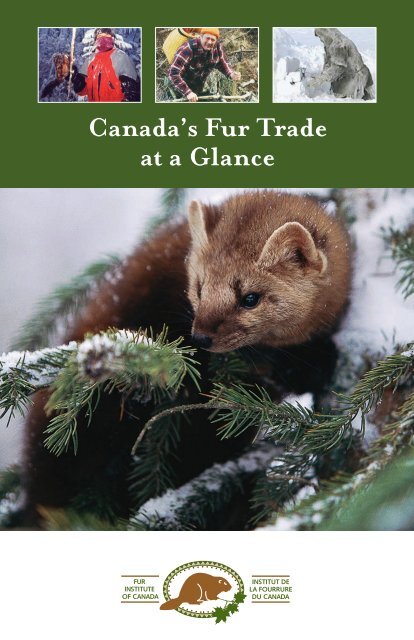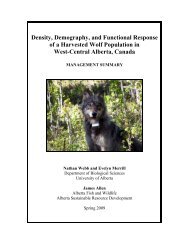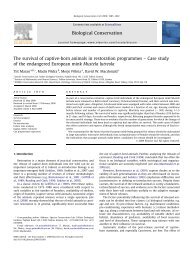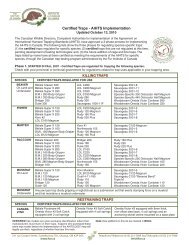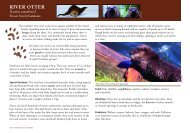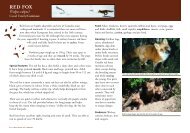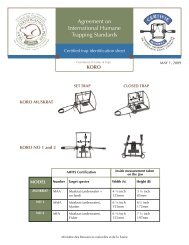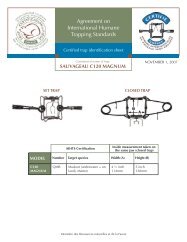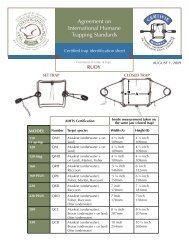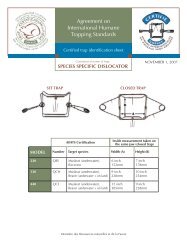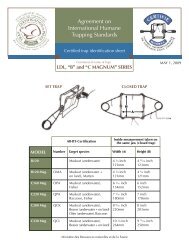Canada's Fur Trade at a Glance - Fur Institute of Canada
Canada's Fur Trade at a Glance - Fur Institute of Canada
Canada's Fur Trade at a Glance - Fur Institute of Canada
You also want an ePaper? Increase the reach of your titles
YUMPU automatically turns print PDFs into web optimized ePapers that Google loves.
<strong>Canada</strong>’s <strong>Fur</strong> <strong>Trade</strong><br />
<strong>at</strong> a <strong>Glance</strong>
“It is recognized th<strong>at</strong> on the same area<br />
<strong>of</strong> land over a 100-year time period, the<br />
value <strong>of</strong> fur production is higher than<br />
forestry value.”<br />
<strong>Fur</strong> <strong>Institute</strong> <strong>of</strong> <strong>Canada</strong><br />
The <strong>Fur</strong> <strong>Institute</strong> <strong>of</strong> <strong>Canada</strong>, a n<strong>at</strong>ional non-pr<strong>of</strong>it organiz<strong>at</strong>ion,<br />
was founded in 1983 with a mand<strong>at</strong>e from the Federal, Provincial<br />
and Territorial Wildlife Ministers to promote the sustainable and<br />
wise use <strong>of</strong> <strong>Canada</strong>’s fur resources.<br />
As a n<strong>at</strong>ion-wide, cross-sector umbrella organiz<strong>at</strong>ion, we are<br />
committed to providing inform<strong>at</strong>ion to the media, the general<br />
public and governments rel<strong>at</strong>ing to the economic, social, cultural<br />
and environmental issues surrounding the harvesting and farming<br />
<strong>of</strong> fur in <strong>Canada</strong>.<br />
<strong>Fur</strong> <strong>Institute</strong> <strong>of</strong> <strong>Canada</strong><br />
701-331 Cooper Street<br />
Ottawa, ON K2P 0G5<br />
For more inform<strong>at</strong>ion visit: www.fur.ca<br />
ISBN: 978-0-9694537-2-7<br />
Copyright 2008 <strong>Fur</strong> <strong>Institute</strong> <strong>of</strong> <strong>Canada</strong>. Printed in <strong>Canada</strong>.
<strong>Canada</strong>’s <strong>Fur</strong> <strong>Trade</strong><br />
<strong>at</strong> a <strong>Glance</strong><br />
The fur trade is part <strong>of</strong> <strong>Canada</strong>’s resource-based<br />
economy and one <strong>of</strong> <strong>Canada</strong>’s oldest and most<br />
historically significant industries. Four hundred<br />
years following its start, the commercial fur<br />
trade continues to utilize a plentiful sustainable<br />
Canadian resource in a responsible manner<br />
and is an important contributor to the<br />
Canadian economy and ecology.<br />
Photo: <strong>Fur</strong> <strong>Institute</strong> <strong>of</strong> <strong>Canada</strong><br />
C a n a d a ’s F u r Tr a d e a t a G l a n c e
Economics<br />
<strong>Canada</strong>’s fur trade contributes more than $800 million 1<br />
to the Canadian economy. i<br />
Income Values<br />
Canadian trappers and fur<br />
farm owners earn more than<br />
$120 million annually in pelt sales. ii<br />
Government Revenues<br />
Provincial and territorial<br />
governments receive nearly<br />
$1.6 million in annual royalty<br />
and licence revenues paid by fur<br />
trappers. Of this, 42% goes<br />
directly to government managed<br />
wildlife habit<strong>at</strong> conserv<strong>at</strong>ion programs.<br />
Canadian Market Values<br />
Estim<strong>at</strong>ed domestic retail fur sales: $300 million. iii<br />
Intern<strong>at</strong>ional <strong>Trade</strong> Value<br />
In 2006, fur exports contributed<br />
$226 million to <strong>Canada</strong>’s balance<br />
<strong>of</strong> trade. iv<br />
Exports <strong>of</strong> pelts and fur apparel<br />
exceeded $450 million in 2006,<br />
part <strong>of</strong> a multi-year upward<br />
trend following a record low<br />
<strong>of</strong> $143 million in 1992. v<br />
World fur trade activity totalled<br />
$13.5 billion in 2006. vi<br />
<strong>Canada</strong>’s most important fur markets are China, Russia and the Ukraine,<br />
Europe (Italy, Germany, UK, Greece, France, Spain), Turkey and Korea.<br />
1 There has been gre<strong>at</strong> fluctu<strong>at</strong>ion in both harvest and price levels over the past 30 years;<br />
the result <strong>of</strong> various supply, demand, social, environmental and economic factors.
C a n a d a ’s F u r Tr a d e a t a G l a n c e<br />
Photo: Beautifully Canadian / <strong>Fur</strong> Council <strong>of</strong> <strong>Canada</strong>
Employment<br />
The Canadian fur trade directly employs 70,000 Canadians. vii<br />
Roughly 250 families, or 750 individuals and family members per<br />
federal riding are directly reliant on the fur trade for their income.<br />
Full and part-time employment in various<br />
fur trade sectors is additional to spin-<strong>of</strong>f<br />
employment in the supply and services<br />
sector, including: feed and equipment<br />
suppliers, veterinary and research services,<br />
by-product production, marketers,<br />
business services, transport, crafts and<br />
design sectors.<br />
<strong>Canada</strong>’s fur industry provides high skilled<br />
jobs and is a significant source <strong>of</strong><br />
employment income for people in rural<br />
and remote areas.<br />
Photo: IFTF<br />
Active trappers: 60,000 (including 25,000 Aboriginal people) 2<br />
Number <strong>of</strong> licensed fur farms: 315 viii<br />
<strong>Fur</strong>-dependent businesses: 815 ix<br />
Regional Significance<br />
Highest number <strong>of</strong> fur farms are loc<strong>at</strong>ed in: Nova Scotia, Ontario,<br />
Newfoundland/Labrador.<br />
The highest level <strong>of</strong> fur trapping occurs in: Quebec, Ontario, Alberta.<br />
More than 85% <strong>of</strong> fur garment manufacturing is loc<strong>at</strong>ed in Montreal.<br />
<strong>Canada</strong> is home to three intern<strong>at</strong>ionally <strong>at</strong>tended, producer-owned<br />
auction houses; two in Ontario and one in B.C.<br />
2 Number <strong>of</strong> licensed trappers in <strong>Canada</strong> will vary from year-to-year and has ranged<br />
between 60,000 and 80,000 over the past decade.
C a n a d a ’s F u r Tr a d e a t a G l a n c e<br />
Photos: <strong>Fur</strong> <strong>Institute</strong> <strong>of</strong> <strong>Canada</strong>
Fast Facts<br />
Wild <strong>Fur</strong><br />
Trapping occurs in virtually every country in the world; the trapping <strong>of</strong><br />
furbearing animals occurs in every region and municipality in <strong>Canada</strong>.<br />
<strong>Fur</strong> products are exported to Europe, Russia, Asia and the USA.<br />
More than 25 Canadian wild fur species are listed for use in the trade,<br />
the most common being: muskr<strong>at</strong> (28%), beaver (21%), marten (13%),<br />
squirrel (9%) and raccoon (5%). x<br />
Beaver garments are the single most important Canadian fur<br />
garment exported. xi<br />
Many Canadian families rely on beaver, muskr<strong>at</strong>, lynx and other wild<br />
furbearing animals for food as well as income.<br />
In addition to oper<strong>at</strong>ing their registered priv<strong>at</strong>e or public trap lines,<br />
pr<strong>of</strong>essional trappers provide a valuable wildlife control service to priv<strong>at</strong>e<br />
landowners and local municipalities across <strong>Canada</strong>.<br />
<strong>Fur</strong> Farming<br />
About two-thirds <strong>of</strong> furs produced in<br />
<strong>Canada</strong> (and as much as 85 percent<br />
worldwide) come from fur farms. xii<br />
In <strong>Canada</strong>, approxim<strong>at</strong>ely<br />
1.65 million mink pelts are<br />
produced by fur farms annually. xiii<br />
In addition to fur, farms provide<br />
valuable oil as le<strong>at</strong>her tre<strong>at</strong>ments and<br />
fertilizer by-products such as bone<br />
and blood meal.<br />
Photo: IFTF
C a n a d a ’s F u r Tr a d e a t a G l a n c e<br />
Photo: IFTF
Regul<strong>at</strong>ion<br />
The farming and trapping <strong>of</strong> fur animals are provincially licensed and<br />
regul<strong>at</strong>ed. Farming and trapping are also consistent with intern<strong>at</strong>ional<br />
agreements such as CITES (Convention on Intern<strong>at</strong>ional <strong>Trade</strong> in<br />
Endangered Species), the Convention on Biological Diversity (CBD)<br />
and the IUCN (World Conserv<strong>at</strong>ion Union).<br />
Provincial and Territorial wildlife biologists establish regional<br />
management plans to ensure healthy furbearer popul<strong>at</strong>ions.<br />
An intern<strong>at</strong>ional agreement signed<br />
by <strong>Canada</strong>, Russia and the European<br />
Union in 1997 establishes scientific<br />
protocols for humane trapping<br />
standards. The United St<strong>at</strong>es signed<br />
a separ<strong>at</strong>e, but similar, agreement<br />
with the EU. Following ten years <strong>of</strong><br />
testing, implement<strong>at</strong>ion <strong>of</strong> the<br />
Agreement on Intern<strong>at</strong>ional Humane<br />
Trapping Standards (AIHTS) began<br />
in <strong>Canada</strong> in the fall <strong>of</strong> 2007. The<br />
Agreement requires th<strong>at</strong> wild furs be<br />
taken in accordance with scientifically<br />
verified and intern<strong>at</strong>ionally accepted<br />
humane systems.<br />
The <strong>Fur</strong> <strong>Institute</strong> <strong>of</strong> <strong>Canada</strong> is the<br />
<strong>of</strong>ficial trap testing agency for the<br />
government <strong>of</strong> <strong>Canada</strong> and all<br />
Provincial/Territorial governments.<br />
“Trappers receive training,<br />
and trapping is carefully<br />
regul<strong>at</strong>ed through<br />
registered trapping areas,<br />
harvest quotas, hunting<br />
seasons, and other<br />
measures to prevent overharvesting<br />
and to ensure<br />
th<strong>at</strong> the best available<br />
methods are used to<br />
promote responsible<br />
conserv<strong>at</strong>ion.”<br />
Ontario Ministry<br />
<strong>of</strong> N<strong>at</strong>ural Resources<br />
Research<br />
Since 1984, more than $15 million has been invested in the<br />
intern<strong>at</strong>ionally recognized Canadian trap research and development<br />
program, coordin<strong>at</strong>ed by the <strong>Fur</strong> <strong>Institute</strong> <strong>of</strong> <strong>Canada</strong> and conducted <strong>at</strong><br />
the Alberta Research Council’s Vegreville facility and in conjunction<br />
with veterinarians and pr<strong>of</strong>essional trappers. xiv<br />
Trappers particip<strong>at</strong>e in ecological field studies, wildlife distribution<br />
and popul<strong>at</strong>ion studies, wildlife reloc<strong>at</strong>ion projects, forestry
Photos: <strong>Fur</strong> <strong>Institute</strong> <strong>of</strong> <strong>Canada</strong><br />
Photo: IFTF<br />
management planning, wildlife<br />
vaccin<strong>at</strong>ion programs, trap testing,<br />
and disease monitoring.<br />
Farmed fur associ<strong>at</strong>ions have initi<strong>at</strong>ed<br />
or contributed to Canadian research<br />
and development in furbearer health,<br />
nutrition, behaviour, housing and<br />
management. The Nova Scotia <strong>Fur</strong><br />
<strong>Institute</strong> (NSFI) in collabor<strong>at</strong>ion<br />
with the Nova Scotia Agricultural<br />
College (NSAC) and Nova Scotia<br />
<strong>Fur</strong>-animal research results<br />
have in many instances<br />
been incorpor<strong>at</strong>ed into<br />
law and/or trapping and<br />
farming practices.<br />
Intern<strong>at</strong>ional <strong>Fur</strong> <strong>Trade</strong><br />
Feder<strong>at</strong>ion<br />
Department <strong>of</strong> Agriculture and Marketing (NSDAM) has been<br />
funding published fur research and demonstr<strong>at</strong>ion initi<strong>at</strong>ives, since<br />
its inception in 1984. The <strong>Fur</strong> Research Chair position <strong>at</strong> the NSAC<br />
was cre<strong>at</strong>ed in 1994 and has a n<strong>at</strong>ional mand<strong>at</strong>e.<br />
C a n a d a ’s F u r Tr a d e a t a G l a n c e
Time-line:<br />
<strong>Canada</strong>’s Commercial <strong>Fur</strong> <strong>Trade</strong><br />
1497 John Cabot discovers <strong>Canada</strong>’s east coast<br />
1534 Jacques Cartier trades for furs with Labrador’s First N<strong>at</strong>ions peoples<br />
1608 Samuel de Champlain establishes North America’s first fur trading<br />
post (Quebec City)<br />
1670 Hudson’s Bay Company chartered as the first company to trade in fur<br />
1700-1870 The height <strong>of</strong> the Canadian <strong>Fur</strong> <strong>Trade</strong><br />
1880s The fashion industry introduces the fur co<strong>at</strong><br />
1895 First modern-day fur farm (Prince Edward Island)<br />
1940s Adoption <strong>of</strong> modern wildlife management<br />
1948 <strong>Canada</strong> joins the World Conserv<strong>at</strong>ion Union (IUCN)<br />
1954 Canadian Associ<strong>at</strong>ion for Humane Trapping (CAHT) established<br />
1968 Beginning <strong>of</strong> the modern-day anti-fur movement<br />
1975 <strong>Canada</strong> joins the Convention on Intern<strong>at</strong>ional <strong>Trade</strong> in Endangered<br />
Species <strong>of</strong> Wild Fauna and Flora (CITES)<br />
1983 Canadian Trap Research and Testing program begins<br />
1984 “Recommended Code <strong>of</strong> Practice for the Care and Handling<br />
<strong>of</strong> Farmed Mink”<br />
1987 Hudson’s Bay Company sells its Canadian fur auction business<br />
to Canadian fur producer associ<strong>at</strong>ions, now known as North<br />
American <strong>Fur</strong> Auctions<br />
1989 “Recommended Code <strong>of</strong> Practice for the Care and Handling<br />
<strong>of</strong> Ranched Fox”<br />
1992 <strong>Canada</strong> joins the United N<strong>at</strong>ions Convention on Biological Diversity<br />
1997 Agreement on Intern<strong>at</strong>ional Humane Trapping Standards (AIHTS)<br />
2007 Implement<strong>at</strong>ion <strong>of</strong> phase one <strong>of</strong> AIHTS
Photo: Beautifully Canadian / <strong>Fur</strong> Council <strong>of</strong> <strong>Canada</strong><br />
1890s Alberta fur trader<br />
Photos: Archives/Public Domain<br />
C a n a d a ’s F u r Tr a d e a t a G l a n c e
Today, the success <strong>of</strong> <strong>Canada</strong>’s fur trade is as<br />
much a recognition <strong>of</strong> a centuries-old tradition<br />
<strong>of</strong> excellence as it is a modern example <strong>of</strong> the<br />
sound applic<strong>at</strong>ion <strong>of</strong> conserv<strong>at</strong>ion principles<br />
and sustainable development.<br />
Photo: Claude Camirand<br />
References<br />
i Intern<strong>at</strong>ional <strong>Fur</strong> <strong>Trade</strong> Feder<strong>at</strong>ion<br />
ii STATISTICS CANADA, Agriculture Division,<br />
2006 Census <strong>of</strong> Wildlife Pelt Production and “<strong>Fur</strong> Farm Report”<br />
iii <strong>Fur</strong> Council <strong>of</strong> <strong>Canada</strong>, 2006<br />
iv STATISTICS CANADA, Intern<strong>at</strong>ional <strong>Trade</strong> Division, 2006<br />
v <strong>Fur</strong> Council <strong>of</strong> <strong>Canada</strong>, 2008<br />
vi Intern<strong>at</strong>ional <strong>Fur</strong> <strong>Trade</strong> Feder<strong>at</strong>ion 2007 report<br />
vii <strong>Fur</strong> Council <strong>of</strong> <strong>Canada</strong>, 2006<br />
viii STATISTICS CANADA, “<strong>Fur</strong> Farm Report”, 2006<br />
ix <strong>Fur</strong> Council <strong>of</strong> <strong>Canada</strong>, 2006<br />
x STATISTICS CANADA, 1999-2006 Census <strong>of</strong> Wildlife Pelt Production<br />
xi ibid<br />
xii Intern<strong>at</strong>ional <strong>Fur</strong> <strong>Trade</strong> Feder<strong>at</strong>ion and STATISTICS CANADA, 2006<br />
xiii STATISTICS CANADA, “<strong>Fur</strong> Farm Report”, 2006<br />
xiv <strong>Fur</strong> <strong>Institute</strong> <strong>of</strong> <strong>Canada</strong>, 2007


